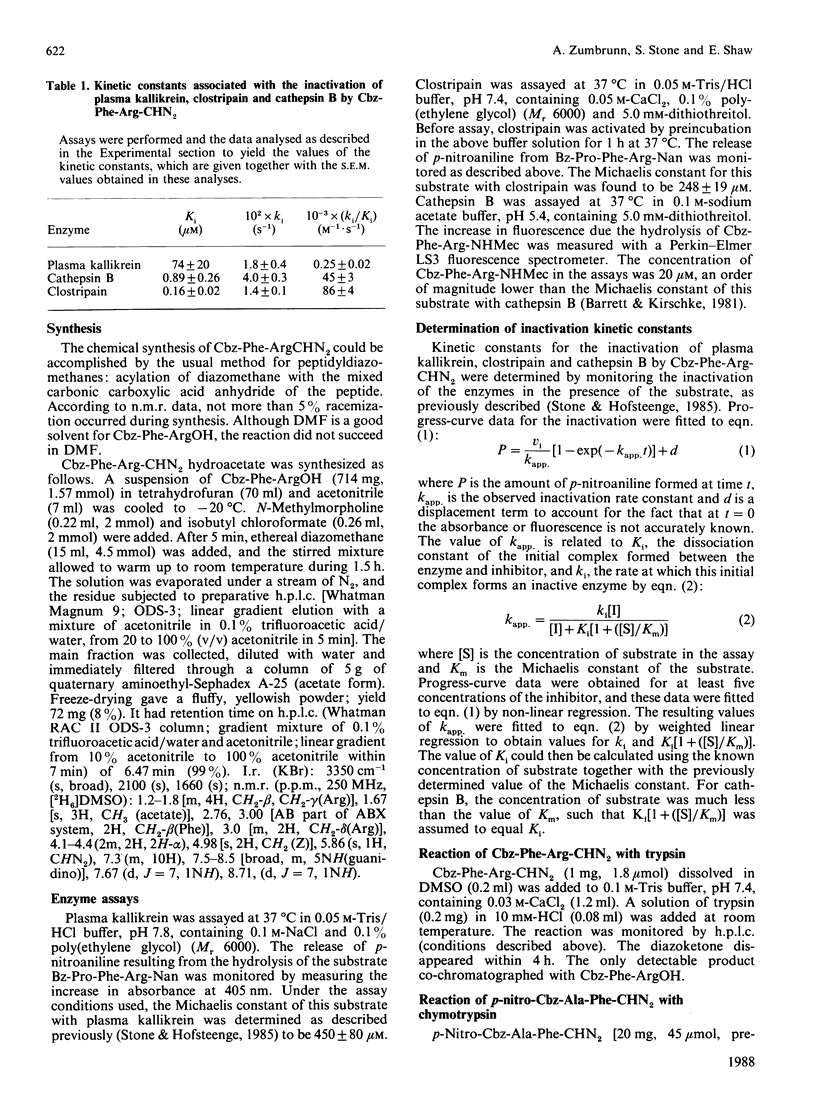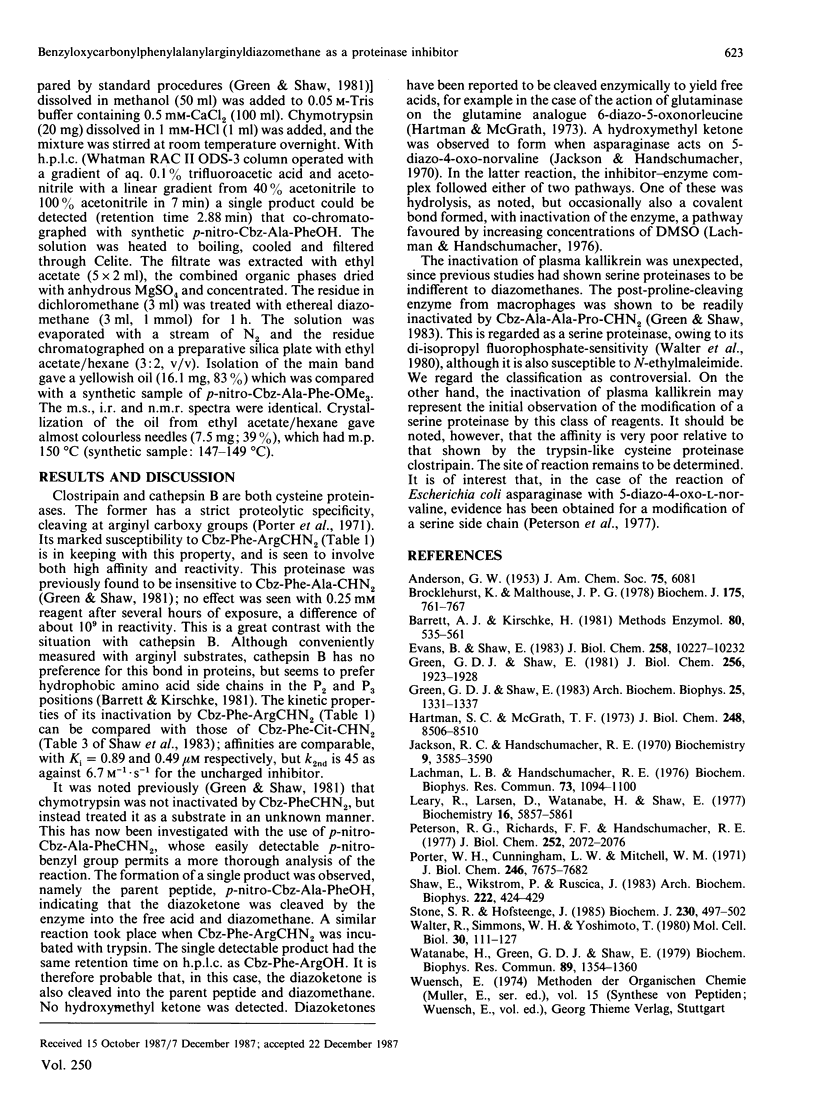Abstract
The preparation of peptides terminating in -Arg-CHN2 has been attempted because of their potential value as proteinase inactivators. We have succeeded in one case, converting Cbz-Phe-ArgOH to the diazomethane without blocking the guanidino group. As expected from previous results with such reagents, the new derivative was extremely effective in inactivating a cysteine proteinase specific for cleaving at arginyl bonds, that is, clostripain. However, in contrast with the inertness of serine proteinases to reagents of this type in the cases examined previously, plasma kallikrein was inactivated by Cbz-Phe-Arg-CHN2, although with a considerably lower rate constant than with clostripain. Trypsin, however, was not inactivated, but gradually destroyed the reagent, as had been observed previously with chymotrypsin and Cbz-Phe-CHN2. This has now been re-examined with rho-nitro-Cbz-Ala-Phe-CHN2 and shown to involve a cleavage to rho-nitro-Cbz-Ala-PheOH, probably with liberation of diazomethane.
Full text
PDF


Selected References
These references are in PubMed. This may not be the complete list of references from this article.
- Barrett A. J., Kirschke H. Cathepsin B, Cathepsin H, and cathepsin L. Methods Enzymol. 1981;80(Pt 100):535–561. doi: 10.1016/s0076-6879(81)80043-2. [DOI] [PubMed] [Google Scholar]
- Brocklehurst K., Malthouse J. P. Mechanism of the reaction of papain with substrate-derived diazomethyl ketones. Implications for the difference in site specificity of halomethyl ketones for serine proteinases and cysteine proteinases and for stereoelectronic requirements in the papain catalytic mechanism. Biochem J. 1978 Nov 1;175(2):761–764. doi: 10.1042/bj1750761. [DOI] [PMC free article] [PubMed] [Google Scholar]
- Evans B., Shaw E. Inactivation of cathepsin B by active site-directed disulfide exchange. Application in covalent affinity chromatography. J Biol Chem. 1983 Sep 10;258(17):10227–10232. [PubMed] [Google Scholar]
- Green G. D., Shaw E. Peptidyl diazomethyl ketones are specific inactivators of thiol proteinases. J Biol Chem. 1981 Feb 25;256(4):1923–1928. [PubMed] [Google Scholar]
- Hartman S. C., McGrath T. F. Glutaminase A of escherichia coli. Reactions with the substrate analogue, 6-diazo-5-oxonorleucine. J Biol Chem. 1973 Dec 25;248(24):8506–8510. [PubMed] [Google Scholar]
- Jackson R. C., Handschumacher R. E. Escherichia coli L-asparaginase. Catalytic activity and subunit nature. Biochemistry. 1970 Sep 1;9(18):3585–3590. doi: 10.1021/bi00820a013. [DOI] [PubMed] [Google Scholar]
- Lachman L. B., Handschumacher R. E. The active site of L-asparaginase: dimethylsulfoxide effect of 5-diazo-4-oxo-L-norvaline interactions. Biochem Biophys Res Commun. 1976 Dec 20;73(4):1094–1100. doi: 10.1016/0006-291x(76)90235-7. [DOI] [PubMed] [Google Scholar]
- Leary R., Larsen D., Watanabe H., Shaw E. Diazomethyl ketone substrate derivatives as active-site-directed inhibitors of thiol proteases. Papain. Biochemistry. 1977 Dec 27;16(26):5857–5861. doi: 10.1021/bi00645a033. [DOI] [PubMed] [Google Scholar]
- Peterson R. G., Richards F. F., Handschumacher R. E. Structure of peptide from active site region of Escherichia coli L-asparaginase. J Biol Chem. 1977 Mar 25;252(6):2072–2076. [PubMed] [Google Scholar]
- Porter W. H., Cunningham L. W., Mitchell W. M. Studies on the active site of clostripain. The specific inactivation by the chloromethyl ketone derived from -N-tosyl-L-lysine. J Biol Chem. 1971 Dec 25;246(24):7675–7682. [PubMed] [Google Scholar]
- Shaw E., Wikstrom P., Ruscica J. An exploration of the primary specificity site of cathepsin B. Arch Biochem Biophys. 1983 Apr 15;222(2):424–429. doi: 10.1016/0003-9861(83)90540-4. [DOI] [PubMed] [Google Scholar]
- Stone S. R., Hofsteenge J. Specificity of activated human protein C. Biochem J. 1985 Sep 1;230(2):497–502. doi: 10.1042/bj2300497. [DOI] [PMC free article] [PubMed] [Google Scholar]
- Walter R., Simmons W. H., Yoshimoto T. Proline specific endo- and exopeptidases. Mol Cell Biochem. 1980 Apr 18;30(2):111–127. doi: 10.1007/BF00227927. [DOI] [PubMed] [Google Scholar]
- Watanabe H., Green G. D., Shaw E. A comparison of the behavior of chymotrypsin and cathepsin B towards peptidyl diazomethyl ketones. Biochem Biophys Res Commun. 1979 Aug 28;89(4):1354–1360. doi: 10.1016/0006-291x(79)92158-2. [DOI] [PubMed] [Google Scholar]


